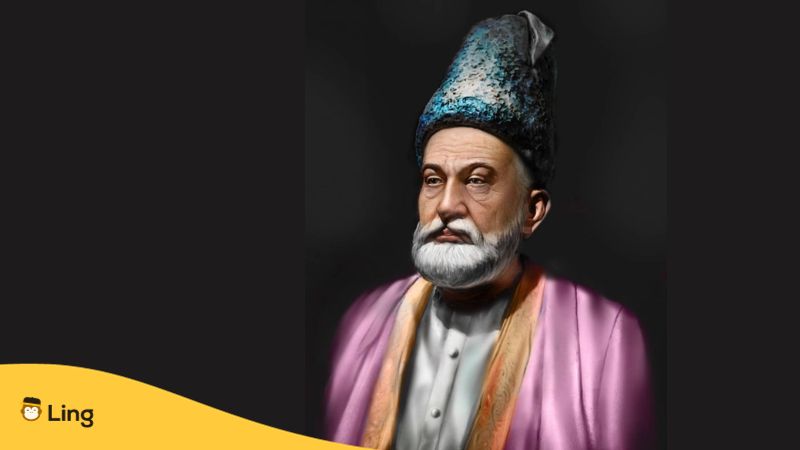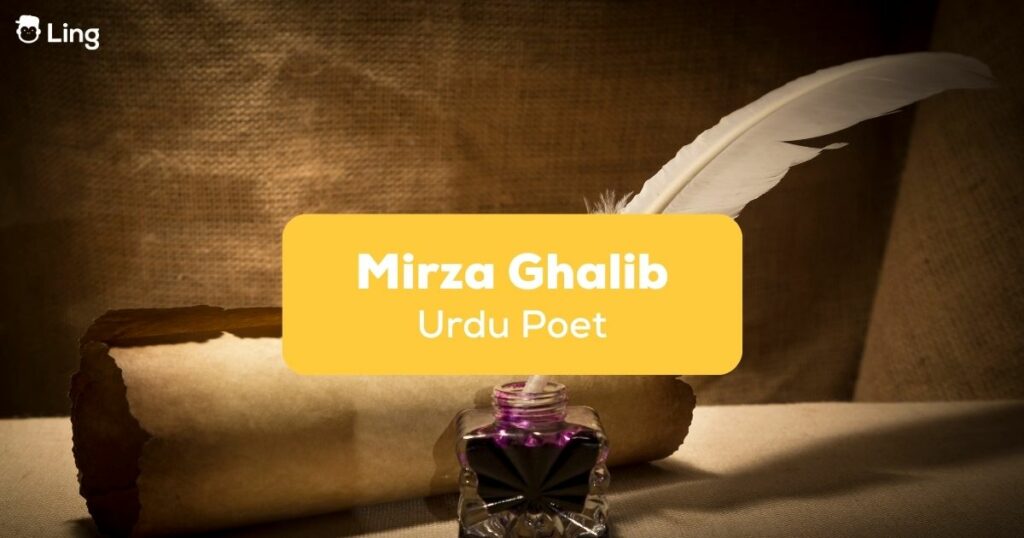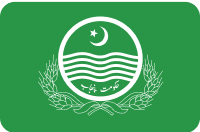If you are an Urdu language enthusiast, the probability is that you would have heard the name Mirza Ghalib at least once in your lifetime. On his 226th birth anniversary today, December 27th, let’s find out what makes him the face of Urdu to those uninitiated.
My introduction to Urdu poetry and its foundation stone – Mirza Ghalib – was at a young age. At 10 or 11 years old, most probably. Sunday mornings with my dad at home, playing his favorite audio recordings of Ghalib’s couplets, as I played or read in the same room.
I still remember being amazed by his hauntingly beautiful couplet – chipak raha hai badan par lahoo se pairaahan, hamari jeb ko ab haajat-e-rafoo kya hai. It was years later, as a college student, that I realized what these beautiful Urdu words meant: (my) robe/shirt is sticking to my bloodied body, what use would it be now to darn my torn pockets? These words point to the lifelong conflict between tending to emotional scars vs investing time to fulfill materialistic needs.
Mirza Asadullah Khan, known more famously as Mirza Ghalib, is the most quoted poet in the Indian subcontinent. He wrote under the pen name Ghalib which means ‘victor’ in Arabic. His philosophical couplets or she’r find resonance in almost all situations in life. As it is said, Ghalib sang ‘all the phases of life’. He is considered to be one of the greatest Urdu and Persian poets and served as the royal poet in the court of the last Mughal Emperor Bahadur Shah Zafar II.
Here is a look at Ghalib’s illustrious poetic career on his birthday.

Brief Biography
Mirza Ghalib was born on December 27, 1797, in Agra, India, and belonged to a family steeped in Persian literary traditions. As a young boy, Ghalib learned Persian, Arabic, philosophy, and logic, but he was more interested in composing poetry. He saw tragedy at the young age of five when his father died, and later when his guardian too passed away when he was merely nine. This difficult period inspired some of Ghalib’s earliest ghazals.
Ghalib later moved to Delhi as the Mughal court was shifting its base there. He was appointed as the royal poet in Emperor Bahadur Shah Zafar II’s court in 1854. Ghalib lived through the downfall of the Mughal empire, the Indian Rebellion of 1857, and the aftermath. He witnessed a time of great political turmoil. Ghalib died on February 15, 1869, at the age of 71.
Most Famous Works
Ghalib wrote in Persian as well as in Urdu. His Urdu ghazal are considered to be the epitome of that poetic form. Some of his most famous works are the collection of poems Diwan-e-Ghalib, letters Ghalib ke Khatoot, and poems like Masnavi Ghalib. He is best known for his ingenious use of literary devices like metaphor, irony, and double entendres in his couplets or ash’aar.
Famous Couplets
Here is a look at 10 of Ghalib’s most famous couplets and their English translations.
| English Translation | Urdu | Transliteration |
|---|---|---|
| I am aware of the realities of heaven, but it is good to keep up the illusion to keep the heart happy, Ghalib | ہم کو معلوم ہے جنت کی حقیقت لیکن دل کے خوش رکھنے کو غالبؔ یہ خیال اچھا ہے | Ham ko maalūm hai jannat kī haqīqat lekin dil ke ḳhush rakhne ko ‘ġhālib’ ye ḳhayāl achchhā hai |
| (I) have a thousand desires and each desire worth dying for, I have realized many of those and yet a many remain | ہزاروں خواہشیں ایسی کہ ہر خواہش پہ دم نکلے بہت نکلے مرے ارمان لیکن پھر بھی کم نکلے | Hazāroñ ḳhvāhisheñ aisī ki har ḳhvāhish pe dam nikle bahut nikle mire armān lekin phir bhī kam nikle |
| There is hardly a difference between living and dying when in love, (I somehow) manage to live looking at the beloved – the one who be the reason of my death | محبت میں نہیں ہے فرق جینے اور مرنے کا اسی کو دیکھ کر جیتے ہیں جس کافر پہ دم نکلے | Mohabbat meñ nahīñ hai farq jiine aur marne kā usī ko dekh kar jiite haiñ jis kāfir pe dam nikle |
| One glance from them (beloved) brings a glow to (my) face, yet it makes them think (I am) recovering well from my illness | ان کے دیکھے سے جو آ جاتی ہے منہ پر رونق وہ سمجھتے ہیں کہ بیمار کا حال اچھا ہے | Un ke dekhe se jo aa jaatī hai muñh par raunaq vo samajhte haiñ ki bīmār kā haal achchhā hai |
| It wasn’t in my destiny to be united with my beloved, even if (I) would have lived longer, I would have kept waiting for them | یہ نہ تھی ہماری قسمت کہ وصال یار ہوتا اگر اور جیتے رہتے یہی انتظار ہوتا | Ye na thī hamārī qismat ki visāl-e-yār hotā agar aur jiite rahte yahī intizār hotā |
| (I am) not impressed by the blood simply flowing in the veins (merely existing), if not shed from the eye, what is the use of that blood? | رگوں میں دوڑتے پھرنے کے ہم نہیں قائل جب آنکھ ہی سے نہ ٹپکا تو پھر لہو کیا ہے | Ragoñ meñ dauḌte phirne ke ham nahīñ qaa.il jab aañkh hī se na Tapkā to phir lahū kyā hai |
| When there was nothing, there was God, when nothing remains, He’ll still be there, My downfall was my ‘being’ (ego), how great it’d be if ‘I’ was not there | نہ تھا کچھ تو خدا تھا کچھ نہ ہوتا تو خدا ہوتا ڈبویا مجھ کو ہونے نے نہ ہوتا میں تو کیا ہوتا | Na thā kuchh to ḳhudā thā kuchh na hotā to ḳhudā hotā Duboyā mujh ko hone ne, na hotā maiñ to kyā hotā |
| When man gets accustomed to pain, the pain vanishes I suffered so many difficulties that they ultimately became easy | رنج سے خوگر ہوا انساں تو مٹ جاتا ہے رنج مشکلیں مجھ پر پڑیں اتنی کہ آساں ہو گئیں | Rañj se ḳhūgar huā insāñ to miT jaatā hai rañj mushkileñ mujh par paḌīñ itnī ki āsāñ ho ga.iiñ |
| As a drop (of happiness) dissolves after meeting the ocean, the pain turns into medicine after reaching its limits | عشرت قطرہ ہے دریا میں فنا ہو جانا درد کا حد سے گزرنا ہے دوا ہو جانا | Ishrat-e-qatra hai dariyā meñ fanā ho jaanā dard kā had se guzarnā hai davā ho jaanā |
| This world is like a kids’ playground (to me) Be it day or night, it seems to be a spectacle (to me) | بازیچۂ اطفال ہے دنیا مرے آگے ہوتا ہے شب و روز تماشا مرے آگے | Bāzīcha-e-atfāl hai duniyā mire aage hotā hai shab-o-roz tamāshā mire aage |
Themes in Poetry
Ghalib’s poetry explores complex philosophical ideas as well as the pain and pathos of love. His poems talk about the ephemeral nature of life and the inevitability of death. He often lamented the fading glory of the Mughals in his verses. Ghalib also dwelt on the suffering and poverty he experienced. His mastery of the Urdu language makes his couplets seem deceptively simple, yet they have deeper layers of meaning.
Mirza Ghalib’s Stature and Legacy
In his lifetime, Ghalib saw both praise and criticism. He expressed the pain, despair, and melancholy of the human condition in his ghazals. After his death, Ghalib’s poetic genius was recognized far and wide. He influenced generations of Urdu poets like Iqbal, Faiz, and Mir Taqi Mir. Ghalib’s couplets shine the spotlight on the culture and ethos of the Mughal era. His unique writing style became the hallmark of good poetry. For his outstanding contributions, the Government of India honored Ghalib with a commemorative postage stamp in 1969.
Ghalib’s immortal poetry remains relevant centuries after his death. His verses on the anguish and strains of love as well as the sorrows of life itself, continue to strike a chord with readers. Ghalib is truly the undisputed giant of Urdu literature whose legacy shall endure forever.

































































